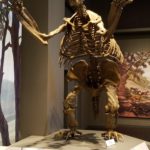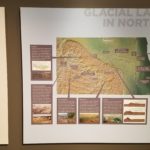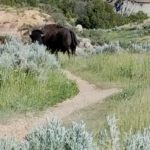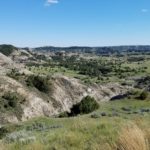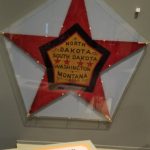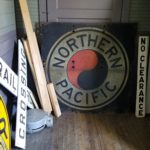There is a lot of evolutionary and geological history in North Dakota. That’s in addition to the beautiful scenery that exists all over the state. And apparently there is a timezone change right in the middle of North Dakota. Which leaves some people in a situation where they commute 5 minutes to work and then are in a different timezone. It’s evidently really annoying for some people who work from home a few days a week (but they deal with it). North Dakota is also the home to the head of the Missouri River and an incredibly impressive dam and power generation system. But first, the Badlands.
Southern Badlands of North Dakota
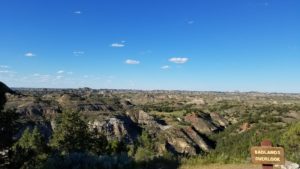 The Badlands of North Dakota, also known as Teddy Roosevelt National Park, are one of the most beautiful places I’ve ever seen. They got their name from the Lakota Indian Tribe who used called the area mako sica, which means land bad. It was called this because the are was known for it’s extreme temperatures, lack of water, and generally difficult to navigate terrain. The painted canyons at the edge of the Badlands share these characteristics. They look like someone just dried up an ocean and you staring at the ocean floor. The park itself has a 36 mile loop that you can drive. On the way you’ll see bison, wild horses, prairie dogs and all the other flora and fauna native to the region. The amazing overlooks and viewing areas throughout the drive make it difficult to see everything you want to see in one go. But all over the Badlands, you can see serene beauty of nature unfold in front of your eyes for miles at a time. There are also times you get a reminder that you we are the visitors on this land. As Charlie and I were hiking up to an observation point, we crested a hill and came face to face with a bison. Charlie growled for what I can only assume was protection not realizing it would do little to deter an 800 pound beast that can easily run 30 miles per hour and turn on a dime. So I took a picture of our stare down with the bison and we slowly backed away to the car. It was a little nerve wracking to say the least being less than 20 feet from an animal of that power with nothing between you and them knowing there is little hope of escape if the bison decides to chase.
The Badlands of North Dakota, also known as Teddy Roosevelt National Park, are one of the most beautiful places I’ve ever seen. They got their name from the Lakota Indian Tribe who used called the area mako sica, which means land bad. It was called this because the are was known for it’s extreme temperatures, lack of water, and generally difficult to navigate terrain. The painted canyons at the edge of the Badlands share these characteristics. They look like someone just dried up an ocean and you staring at the ocean floor. The park itself has a 36 mile loop that you can drive. On the way you’ll see bison, wild horses, prairie dogs and all the other flora and fauna native to the region. The amazing overlooks and viewing areas throughout the drive make it difficult to see everything you want to see in one go. But all over the Badlands, you can see serene beauty of nature unfold in front of your eyes for miles at a time. There are also times you get a reminder that you we are the visitors on this land. As Charlie and I were hiking up to an observation point, we crested a hill and came face to face with a bison. Charlie growled for what I can only assume was protection not realizing it would do little to deter an 800 pound beast that can easily run 30 miles per hour and turn on a dime. So I took a picture of our stare down with the bison and we slowly backed away to the car. It was a little nerve wracking to say the least being less than 20 feet from an animal of that power with nothing between you and them knowing there is little hope of escape if the bison decides to chase.
Lake Sakakawea and the Missouri River
 While there weren’t any museums or anything to do here, I came to the lake and Garrison dam on a recommendation from a couple of guys in a bar in Bismarck, North Dakota. At 178 miles long and 14 miles wide, Lake Sakakawea is the third largest man-made lake in the US and also happens to be at the head of the Missouri River. The Garrison Dam, built from 1947-1954 cost roughly $300 million USD to build. To this day, it is still one of the largest at 2.5 miles long and 0.5 miles wide. There is also a power generation station that creates roughly 2.6 million megawatt hours per year and powers a large part of the region. The real takeaway here is how difficult it is to conceptualize how big this lake actually is.
While there weren’t any museums or anything to do here, I came to the lake and Garrison dam on a recommendation from a couple of guys in a bar in Bismarck, North Dakota. At 178 miles long and 14 miles wide, Lake Sakakawea is the third largest man-made lake in the US and also happens to be at the head of the Missouri River. The Garrison Dam, built from 1947-1954 cost roughly $300 million USD to build. To this day, it is still one of the largest at 2.5 miles long and 0.5 miles wide. There is also a power generation station that creates roughly 2.6 million megawatt hours per year and powers a large part of the region. The real takeaway here is how difficult it is to conceptualize how big this lake actually is.
North Dakota Heritage Museum
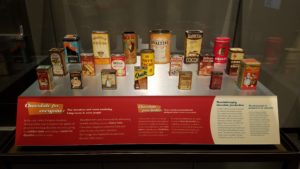 In addition to giving us a calendar that said the end of the world was soon, the Mayans also gave us chocolate. In fact, chocolate was so important to the Mayans that for a long time, it was their currency. It didn’t become a drink of socialites until the 1600s. In 1657, the first chocolate house (similar to coffee shops of today) opened in London for people to drink chocolate and socialize. By the year 1700, there were nearly 2,000 chocolate shops in London alone. There were many other sections of the North Dakota Heritage Museum about the history and evolution of the state. Lots of the information at the museum focused on buffalo, Native Americans, and the historical geological and evolutionary significance of the land. There were giant ground sloths that roamed the plains of North Dakota that could get up to 7-8 feet tall when they stood on their hind legs (picture at the bottom). The coolest part of the museum was that they had a native American elder walking around answering questions and telling stories of events through the eyes of a Native American as opposed to self guided tour.
In addition to giving us a calendar that said the end of the world was soon, the Mayans also gave us chocolate. In fact, chocolate was so important to the Mayans that for a long time, it was their currency. It didn’t become a drink of socialites until the 1600s. In 1657, the first chocolate house (similar to coffee shops of today) opened in London for people to drink chocolate and socialize. By the year 1700, there were nearly 2,000 chocolate shops in London alone. There were many other sections of the North Dakota Heritage Museum about the history and evolution of the state. Lots of the information at the museum focused on buffalo, Native Americans, and the historical geological and evolutionary significance of the land. There were giant ground sloths that roamed the plains of North Dakota that could get up to 7-8 feet tall when they stood on their hind legs (picture at the bottom). The coolest part of the museum was that they had a native American elder walking around answering questions and telling stories of events through the eyes of a Native American as opposed to self guided tour.
Train Museum
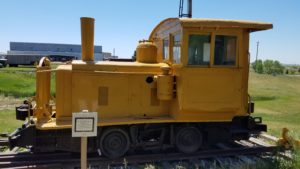 Mandan, North Dakota, just outside of Bismarck, has a great little train museum about the history of the Union Pacific and Burlington Northern railroads. Considering much of the history of the US was built around the commoditization of transportation and shipping, railroads are a massively important part of our history and a large part of what helped push forward the industrial revolution. Talking to the curator of the North Dakota State Rail Museum was fascinating as well. We talked about all things railroad including the difference in land/rail ownership between state, federal, and private rail companies, how railroad land grants actually work as to how they are supposed to work, and how the privatized rail industries created monopolistic tendencies thereby skyrocketing shipping prices. Interestingly, much of this is still true today. Other than a few mergers and technology upgrades, the railroad industry hasn’t changed all that much. But there is a lot of neat train memorabilia from the early days of the railroads.
Mandan, North Dakota, just outside of Bismarck, has a great little train museum about the history of the Union Pacific and Burlington Northern railroads. Considering much of the history of the US was built around the commoditization of transportation and shipping, railroads are a massively important part of our history and a large part of what helped push forward the industrial revolution. Talking to the curator of the North Dakota State Rail Museum was fascinating as well. We talked about all things railroad including the difference in land/rail ownership between state, federal, and private rail companies, how railroad land grants actually work as to how they are supposed to work, and how the privatized rail industries created monopolistic tendencies thereby skyrocketing shipping prices. Interestingly, much of this is still true today. Other than a few mergers and technology upgrades, the railroad industry hasn’t changed all that much. But there is a lot of neat train memorabilia from the early days of the railroads.
Chosen Ones
The whole gallery of pictures from Western North Dakota is available on Google Photos.

